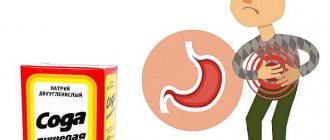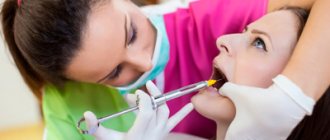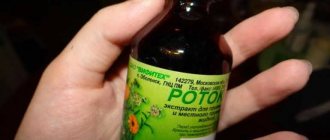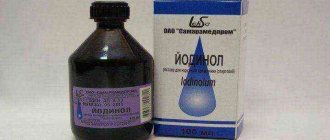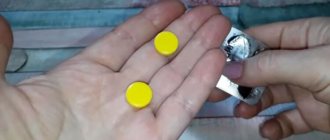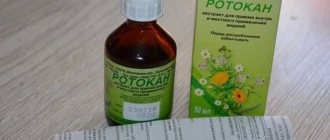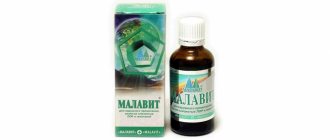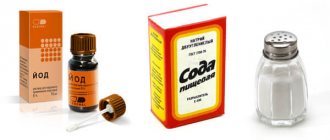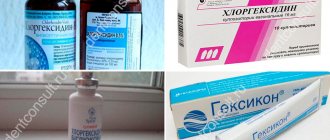What are the benefits of soda-salt solution for mouth rinsing?
The product is widely used for rinsing during the treatment of diseases of the teeth and gums: caries, gingivitis, periodontitis and periodontal disease. The solution helps out in cases where acute symptoms arise suddenly and you need to alleviate the condition before visiting the dentist. The soda-salt composition perfectly relieves inflammation and redness of the mucous membrane, disinfects, has a calming effect and helps to slightly reduce pain.
Sodium bicarbonate or simply soda is a product that is used to clean dirty surfaces, for example, in the kitchen. But a solution with its addition also helps in the treatment of many dental diseases. In combination with salt and sometimes with iodine, soda gives a pronounced antibacterial effect, strengthens hard and soft tissues, and prevents the further spread of the pathological process. Thus, the effect of the composition can be formulated in several main theses:
- has an antibacterial effect,
- helps stop the pathological process and prevents further destruction of the enamel,
- stops inflammatory processes in the mucous membrane,
- helps to significantly reduce pain and alleviate the condition,
- removes bacterial plaque and tartar.
Soda-saline solution helps in the treatment of many dental diseases.
Soda-saline solution is not suitable for daily use. It is recommended in cases where there are clear signs of pathological processes in the oral cavity. The composition can be used for emergency relief of acute symptoms, and as a maintenance agent - only after agreement with the attending physician.
Why is it useful to rinse your mouth with a soda-saline solution?
The soda-salt mixture does not treat diseases of the teeth, mucous membranes of the oral cavity and gum diseases such as caries, gingivitis, and periodontal disease. However, this handy remedy can help a person out if he has a toothache or swollen gums, but for some reason it is currently impossible to get to the dentist.
Baking soda (sodium bicarbonate) is used not only for cleaning dirty surfaces or in culinary production. A solution based on this product is actively used for rinsing and washing the mouth and teeth. Additional ingredients in the composition of the healing product may include iodine, salt and essential oils in various proportions. In some recipes, the usual table salt is replaced with sea salt, which is more expensive and has greater benefits.
The benefits of soda and soda-salt mixtures for the health of teeth and soft tissues of the oral cavity are multifaceted. This home remedy can help solve a whole range of dental problems because:
- Has an antimicrobial effect.
- Helps prevent harmful acids from destroying tooth enamel.
- Stops the inflammatory process.
- Helps make tooth pain less painful and the patient’s condition more comfortable.
- Can help get rid of tartar and plaque.
When preparing mixtures for rinsing the mouth and performing oral baths, the ingredients should be measured in strict accordance with the proportions recommended in the recipes in order to avoid burns of the oral mucosa, damage to the integrity of the enamel and other painful reactions.
Indications for use
It is better to use the composition for rinsing on the recommendation of a specialist - the treating dentist. The main indications for use are listed below:
- heavy plaque, supra- and subgingival deposits, unpleasant odor: the composition effectively fights bacteria in the oral cavity, dissolves hardening deposits and prevents the growth of pathogenic microflora. In addition, the active ingredients have a beneficial effect on the enamel and help strengthen it, and by cleaning surfaces from bacteria and their metabolic products, breath is freshened,
- severe toothache: it is not possible to cure the problem with just rinsing, but it is quite possible to significantly reduce the intensity of acute symptoms. The product will help normalize the condition so you can safely get to the doctor,
- after tooth extraction: preventive rinsing with a soda-salt solution will help fight bacteria, prevent wound infection, help stop bleeding and stimulate healing processes. You just need to rinse carefully so as not to damage the blood clot in the hole,
- diseases of the teeth and gums: rinsing with salt and soda is recommended, among other things, as maintenance therapy during the treatment of caries, gingivitis, periodontitis and periodontal disease, periodontitis and periostitis with purulent processes - according to indications and only in concentrations recommended by a specialist.
Rinsing helps in the treatment of inflammation of the gums and dental plaque.
If there are microtraumas or cuts in the mouth, which may appear, for example, due to braces or incorrectly installed fillings, crowns and dentures, then such a solution will help to effectively disinfect tissues, and its regular use will help their rapid healing.
What not to do after tooth extraction
During the first time after tooth extraction
absolutely
not allowed
:
- Touch the wound hole
with toothpicks, hard bristled brushes and other foreign objects. - There are fermented milk products. This is an excellent breeding ground for bacteria to grow.
- Go to the gym, swimming pool and bathhouse, including the sauna.
- Drink something hot and warm the wound with something.
- Chew on the side of the mouth where the tooth was removed.
- Smoking.
When is it better to avoid rinsing - contraindications
If the recommended dosages are observed, the medicinal solution is completely harmless and safe. But in some pathological conditions and individual intolerance to its components, the use of the product is strictly contraindicated.
So, it is better not to add soda to the composition if a small child is going to rinse the mouth. Under the age of 3-4 years, a child can easily accidentally swallow the concentrated composition, and this is fraught with stomach problems. It is better to soak a cotton swab or a small piece of gauze in the solution, and then apply it to the sore spot for just a few minutes.
Do not use the rinse solution for children under 3-4 years of age.
You should not rinse your mouth with salt and soda if you have a traumatic brain injury, brain disease, or a predisposition to a stroke. In case of thyroid dysfunction, tuberculosis and nephritis, iodine1 should not be added to the main composition. The same applies to women during pregnancy and breastfeeding. Do not rinse too often if they provoke attacks of nausea.
How to prepare a universal soda-salt solution
To prepare the medicinal composition, you need to take a glass of boiled warm water - approximately 27-30 °C, and dilute a teaspoon of soda and salt in it. It is important to stir the bulk ingredients until completely dissolved. After this, you need to rinse your mouth thoroughly for 1-2 minutes, paying special attention to the sore area. By the way, the ingredients are good on their own. So, to relieve acute pain and symptoms of inflammation, you can rinse your mouth with only salt or only soda. In some cases, it is possible to add a few drops of iodine to enhance the effect.
Types of rinsing solutions
- Soda. Sodium bicarbonate has a good antifungal effect, soda is effective as a prophylaxis against gum inflammation. It is recommended to add a teaspoon of the chemical element to a glass of warm boiled water. The advantages of the solution include the fact that it gently cleanses the oral cavity and tooth enamel and has a good disinfectant effect.
- Salt. Saline solution is a good antiseptic. To prepare, dilute a spoonful of salt in a glass of warm water. Salt promotes rapid healing of cracks and wounds, soothes the diseased element of the dental system.
- Soda-salt. The use of soda-salt solution is the most effective therapeutic and preventive method. In this case, mix a teaspoon of soda and salt in a glass of warm water. The best option when the first symptoms of various dental pathologies appear.
- Soda-salt with iodine. An indispensable assistant in solving various dental problems. It is necessary to rinse your mouth with iodine, salt and soda in the right proportions. Half a teaspoon of soda and salt and a drop of iodine are diluted in warm water. Everything is thoroughly mixed. It is used as a prophylaxis for bleeding gums and for the treatment of all kinds of inflammatory processes.
We looked at how you can make soda-salt baths using various additional components. Today there is a wide variety of solutions, but it is necessary to consult a specialist. Following the doctor’s recommendations will help prevent drying of the mucous membrane, increased sensitivity of the enamel and other negative phenomena.
How to use the product correctly
Before rinsing, be sure to brush your teeth. The temperature of the liquid should not exceed 30 °C - ideally it should be slightly warmer than room temperature. Too high a temperature can cause a burn, and cold can increase the pain. You need to use only freshly prepared solution, otherwise it will lose some of its properties. The product should not be swallowed; it must be spat out at the end of the procedure.
“I take out salt and soda only in extreme cases, when someone in the family has an acute inflammation, for example, gumboil. But you can’t use them every day, that’s for sure! A regular pharmaceutical product like Listerine or Colgate is sufficient for daily use. I deliberately take a little less liquid, because if you do it according to the instructions, sometimes it makes your teeth cramp. And a bottle is enough for our family for 2 weeks..."
Ulyasha, from correspondence on the woman.ru forum
If the pain is too severe, it is better to extend the procedure to 5 minutes. In this case, the liquid will have to be renewed every half a minute. It is important to understand that rinsing will help dull severe symptoms, but not cure the disease. Immediately after the condition returns to normal, you should urgently go to the doctor.
Rinsing will help dull severe symptoms, but will not cure the disease.
Rinse your mouth with saline solution
Salt has a pronounced antiseptic effect. It accelerates the healing of wounds and small cuts on the mucous membrane, and also prevents the growth of pathogenic microflora. In combination with soda, it effectively reduces inflammation, reduces the intensity of purulent processes, and helps to slightly reduce pain. The product is recommended for use on gums, mainly in cases of acute inflammatory processes accompanied by the release of pus - periodontitis, periostitis, etc.
The effectiveness of soda solution
Baking soda also relieves inflammation, but also has an antifungal effect. Due to its abrasive properties, the powder perfectly cleanses the enamel of bacterial plaque and other contaminants, helping to restore its natural shine and whiteness. In addition, soda disinfects tissues, reduces swelling and soreness. It is only important to follow the recommended proportions, otherwise you can easily burn the mucous membrane.
Remedy with soda and salt against pain and inflammation
With the development of dental diseases of an infectious nature, accompanied by acute symptoms, a mixture of soda and salt, diluted in boiled water in equal proportions, helps well. The product relieves toothache and prevents the further spread of the pathological process. The composition can be used as an emergency aid or as part of maintenance therapy after consultation with a specialist.
Soda-salt composition with added iodine
If you add a few drops of iodine to salt and soda, you can significantly enhance the effect of the drug. Iodine actively fights pathogenic microflora and prevents the proliferation of pathogens. All three components in combination with each other provide a pronounced analgesic effect and help reduce bleeding and swelling of soft tissues. You just need to be careful with iodine - you need to strictly adhere to the dosage and take into account possible contraindications.
Iodine actively fights pathogenic microflora
What to rinse with?
Keep in mind that you don't need to literally rinse your mouth.
, and arrange a therapeutic bath for the wound left
after tooth extraction
. So eliminate the efforts that create seething, so as not to damage the first healing processes.
- First aid
in this case is a solution of a teaspoon of salt and the same amount of soda in a glass of warm water. They are in every home. This rinse should relieve pain and disinfect the wound hole. - At the Pharmacy
you can always stock up on furatsilin to disinfect a sore spot. The solution requires one tablet per glass of water. A solution of chlorhexidine (0.05%) or miramistin is also suitable. The latter remedy also has a good analgesic effect. All medications are very inexpensive.
Many anti-inflammatory and disinfectant herbs, as well as those that have a healing effect, are suitable from your grandmother’s herbalist They are prepared in approximately the same way - cook a little for 15 minutes in a water bath, strain, cool and rinse. Chamomile, calendula, sage and eucalyptus are better suited than others, and it is better to use all at the same time in equal shares. You can also use St. John's wort, oregano and pine needles.- If
swelling
occurs the tooth was removed , then briefly apply ice to the sore spot and rinse the hole with soda and furatsilin. - If the pain occurs after removing the nerve of the tooth
, then rinsing with propolis infusion and the same soda solution, but with a few drops of iodine, helps a lot.
If after several days the pain does not subside, the bleeding does not stop, and any additional unpleasant symptoms arise, you should definitely seek help from a dentist. Another piece of advice: if you know that you have poor blood clotting, notify the surgeon about this and ask him to sew up the wound, having first put the medicine in the hole. This will facilitate and speed up the healing of the gums.
Recommendations for preparing the product for different occasions
The solution is very easy to prepare, and the ingredients for it can be found in any home. Just keep in mind that the liquid needs to be prepared anew each time, and to dilute the components you should use warm boiled water or room temperature. Depending on the problem, recommendations for using the composition may be different - let's look at them in more detail.
When a toothache takes you by surprise
To relieve acute pain in teeth, it is recommended to dilute a teaspoon of salt in a glass of warm water. You can rinse your mouth every half hour until the intensity of the symptom subsides. You can add a teaspoon of soda to the main composition - then the effect will be more pronounced and come faster. Many also advise adding a couple of drops of iodine. On how to properly rinse a sore tooth, experts give the following recommendations:
- Before rinsing, you need to brush your teeth with a brush and toothpaste,
- the solution should be warm or at room temperature - if it is too cold or hot, the pain will only intensify,
- It is better to keep the liquid from the side of the causative tooth, focusing on treating the diseased area,
- There is no need to rinse your mouth with water after the procedure.
Rinsing is also used to relieve acute pain in the teeth.
As mentioned above, upon completion of the procedure, the liquid must be spat out. Each time the composition must be prepared anew, otherwise its effectiveness will significantly decrease.
If there are signs of acute inflammation in the soft tissues
To treat inflamed gums, the composition is recommended in the same proportions - about 200 ml of warm boiled water and a teaspoon of salt and soda. In this case, you can add a couple of drops of sage essential oil or a drop of iodine. Regular rinsing will help relieve swelling and soreness, reduce redness of the gums and strengthen the mucous tissue.
The composition can only be used in courses, and not on an ongoing basis, otherwise the effect may be reversed. The product will speed up the healing process if the mucous membrane hurts after tooth extraction. Only in this case, you shouldn’t rinse too intensely - you can simply hold the liquid behind your cheek on the side of the causative tooth.
While brushing your teeth for prevention
Sometimes salt and soda are recommended to be added to daily dental and oral care products. So, for example, in the composition of toothpaste, these ingredients enhance its abrasive and whitening properties. It is enough to squeeze a small amount of paste onto the brush, then take a little of the mixed powder and brush your teeth thoroughly for a minute.
Baking soda is also used when brushing teeth
Try not to touch your gums, and after completing the procedure, rinse your mouth with plain water. The mixture can be used in this way for a limited period of time. Otherwise, you can seriously injure the enamel, and this is fraught with the development of hyperesthesia and other unpleasant consequences.
Gargling with soda and salt for sore throat - recipes
Soda is a universal remedy that acts on bacteria that cause disease and relieves inflammation and pain.
There are several ways to prepare the solution. The proportions depend on the type of lesion and the duration of the course.
Traditional recipe
- 1 tsp soda.
- 300 ml water.
Just stir the ingredient. One glass - one rinse. The frequency of the latter is at least 5 times a day.
With peroxide
Here you will need 2 glasses of water. Add a spoonful of soda to the first, a spoonful of peroxide to the second. Rinsing is carried out alternately. It needs to be done every 3 hours.
Based on iodine with sea salt
A very effective remedy. To the already prepared classic recipe, add 2 drops of iodine and a spoonful of sea salt.
With salt
No infection will survive this combination. Dissolve a spoonful of each ingredient. Add beaten egg white to the mixture. You'll probably ask why. The reason is the saturation of the solution. Protein will reduce it. Without it, even more inflammation and even burns may appear on the throat. The solution should be used 4 times a day. Salt disinfects affected tissues and kills bacteria living in the oral cavity.
Honey and milk
The recipe differs in that milk is used instead of water and you will have to drink the solution. You only need a pinch of soda and you need to add a spoonful of honey to the drink, you can supplement it with oil. After drinking the formula, you will feel how it coats your throat, reducing pain.
For treatment to be effective, refrain from eating for 60 minutes after treating your throat. Although, if a person is sick, he will not have time for food.
Can it be used during pregnancy?
Regarding the best way to rinse your mouth during pregnancy, you should definitely consult your dentist. It is not prohibited to use a soda-salt solution during this period, however, all precautions must be taken and if a pronounced gag reflex appears, stop the procedure immediately.
You also need to take into account that sometimes the combination of salt, soda and iodine gives an allergic reaction. Solutions with added iodine are generally not recommended during pregnancy. Do not exceed the dosage prescribed by the doctor so as not to provoke complications.
During pregnancy, you should be wary of any treatment methods.
Features of use in childhood
The composition can be given to children only from the age of 5. It is important that the child can already independently control the procedure, otherwise the baby may accidentally swallow the composition, and this is fraught with undesirable consequences for his stomach and digestive system. In addition, the components can leave burns on the mucous membrane.
For older children, the product is prepared according to the same principle, but in a lower concentration - half a teaspoon per glass of warm water. It is better to avoid iodine altogether - the effect of salt and soda is quite enough to relieve acute symptoms and disinfect tissues.
What are the pros and cons?
The main advantages are the availability of ingredients, ease of preparation, effectiveness and safety. Among the key advantages, experts highlight the following points:
- quickly relieves pain and inflammation,
- removes plaque and cleanses enamel, freshens breath,
- stimulates the healing of microtraumas and wounds on the mucous membrane,
- inhibits the formation of dental plaque,
- strengthens hard and soft tissues - the composition is useful for both teeth and gums,
- Easy to prepare from simple and affordable ingredients - a good budget option.
The disadvantages include unpleasant sensations due to enamel hyperesthesia, as well as a specific taste, which in rare cases causes attacks of nausea. In addition, the composition only relieves symptoms, but does not treat the disease itself, so its use is good before or after visiting a doctor, and then only as maintenance therapy.
- Borovsky E.V. Therapeutic dentistry, 2006.
